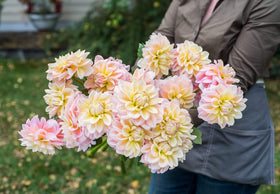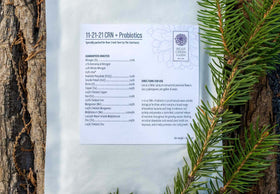At Bear Creek Farm, as we nurture beauty from the ground up. We are ever mindful of the natural tendency of people to overthink the very thing that they are doing to seed joy and grow beauty. We understand. We do this too. Perhaps this trait is part of the soul of the gardener - ever questing for oft-elusive beauty. While squelching our inner perfectionist is hard, so too is it highly suggested. In our view, floral farming is not about the patch of beauty one tends, but rather one’s own place within the larger tapestry of nature. In pursuit of bloom, and in true partnership with all of it from top to bottom glory, growers face many challenges - and assume inherent risk of disappointment. All flower farmers understand the inevitability of pest infestation – and know they will need to make informed choices about how best to combat insects in the garden.
Fortunately, there are many green ways to address this perennial issue.
- At Bear Creek Farm, we work hard to keep our soil chemical-free.
- We encourage others to join us in this practice.
- Nature delivers any number of solutions – many are highly effective - some stemming simply from how one plants.
- Integrating strategic and natural offensive techniques will go a long way to protecting your longed-for velveteen petals.
While we live in a chemical-laden world and the temptation to spray is certainly understandable, we advocate for best practice – even when it means that we must suffer the frustration of a nibbled perfect petal.

Controlling pest infestation is difficult – but before giving into tempting short-cuts, it is important to understand that those healthy flowers spring most readily from healthy soil.
We are here to tell you that there are lots of ways to protect a garden from insects without using chemicals. Among these:
- Companion Planting: Companion planting requires growers to plant certain types of plants next to one another, with a view to creating a kind of tactical jigsaw puzzle using plants known to repel pest or attract beneficial insects. (This is like holding magnets together and feeling the resistance of the poles.) For example, marigolds are known to drive away harmful nematodes, while fennel brings predatory wasps that feed on caterpillars. This sort of practice is fascinating – using the gift of the earth in learning to speak, fluently, the silent language of all things botanical.
- Herbs – Basil, oregano, rosemary and thyme can be useful to deter harmful insects. The compounds in these such as eucalyptol, camphor, carvacrol repel mosquitos, flies and mites. These herbs have the added advantage of being attractants to beneficial insects. (Note too that mint outside your garden can be affective against deer and rodents.)
- Plant a diversity of flowering plants – Ladybugs, lacewings and parasitic wasps all feed on nectar, pollen and insects. Planting a variety of flowers will provide food and make your garden more attractive to them. (These natural predators also like rocks and logs for shelter.)
- Crop Rotation: Crop rotation means that growers rotate their flower beds on an annual basis. This will reduce the remains of the prior year’s pests, as well as remnants of diseases that may be specific to a type of flower.
- Good Clean: Practice good garden hygiene and keep it free of debris to prevent the spread of diseases and pests.
- Handpicking: This simple method means that one removes, by hand, any visible pests. We do this to remove Japanese beetles. While this may sound tedious, it is, in fact, quite therapeutic when one gives in to the rhythm. When one handpicks, one evolves into a full partner with nature – working just as hard as the earth and the soil. (Trust us, you’ll lose track of time. Handpicking becomes a meditative practice.)
- Garlic Oil: Who knew? Garlic oil combined with water and sprayed on plants is a natural pesticide. This may effectively repel insects.
-
Hot Pepper Spray: Once again, who knew? A mixture of hot pepper, water, and dish soap can be used effectively against pests such as aphids, whiteflies, and spider mites. (Make sure to wash your hands, peppers sting the eye.)

What is the well-intended gardener to do if these methods are not effective?
Should these treatments prove ineffective, do not be hasty. There are still multiple green options to employ. When the practices listed above do not adequately address the problem, organic treatments may be used as a last resort. Before continuing to read the practices recommended below, although considered organic, must be used correctly. Read and follow the directions on any purchased product carefully.
- We recommend doing a “patch test” on a small part of your garden and then assessing the results, rather than treating the entire bed at once.
- Make sure to avoid the use of any such treatment where beneficial insects are present.
Treatments include: neem oil, horticultural oil, and Bacillus Thuringiensis (BT) may also be effective. They are linked to nature, rooted in natural sources such as plants, minerals, and microorganisms. Neem oil, for example, which comes from the seeds of the neem tree, has been used for centuries for purposes of protection of crops from pests. Pyrethrin derives from the gorgeous chrysanthemum and may be effective in controlling multiple insects. Bacillus Thuringiensis (BT) comes from soil-borne bacteria. These options are preferable to synthetic pesticides.
Having shared these tips, do know that they will not be across-the-board-effective. In gardening, nothing ever is. Monitoring your garden for general health, and visible pests, etc. is always where one begins. How your garden does year-to-year will depend upon many variables - including climate, pest density, and locale. Some years will deliver a better crop than others, no matter how expert the gardener. We advise tenacity and persistence. The rewards, unexpected though they may be, will follow.
Now that you've finished reading this article, you should check out our tulip planting primer, dahlia growing guide, and cutting guide for dahlias. And if you're shopping for dahlia tubers, make sure to check out our giant dahlia tubers (10"+ blooms), micro dahlia tubers (under 2" blooms), dark pink dahlia tubers, dark red dahlia tubers, and bicolor dahlia tubers.





Excellent. Thank you.
I love what you are doing at your farm. It is possible that the assumptions I am making from looking at all of the wonderful smiling faces in the pictures and reading your blogs are not accurate. But I have a hunch that I am correct in thinking you are a kind, generous, hardworking and humble person. Your thoughtfulness is extended to humans as well as the planet as evidenced in your farming practices. Thank you for sharing your knowledge.
We have been organic for 30 years. We now have so many birds that keep our flowers pest free.
Just want to say I think that was a very well written and informative blog. Thx.